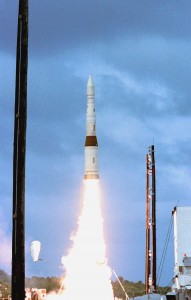 The National Missile Defense program based in Alaska and California, which is designed to protect the United States from a North Korean or Iranian missile attack, continues to be unreliable.
The National Missile Defense program based in Alaska and California, which is designed to protect the United States from a North Korean or Iranian missile attack, continues to be unreliable.
That is the conclusion of a February 17, 2016 General Accountability Office (GAO) report on missile defense concerning the Ground-Based Midcourse system (GMD), aka National Missile Defense.
The GAO study concludes, despite extensive testing, the Missile Defense Agency (MDA) “has not demonstrated through flight testing that it can defend the U.S. homeland against the current missile defense threat.”
In other words, after spending many billions of dollars, the interceptors may work, or may not, but no President of the United States should rely on it.
Instead of focusing on fixing the system first, the Missile Defense Agency is disregarding all warning signs by deploying additional interceptor missiles by 2017. According to the GAO, MDA “relying on high-risk acquisition practices to achieve its goal of fielding 44 interceptors by the end of 2017.”
The GAO went on to report, “MDA is relying on a highly optimistic, aggressive schedule that overlaps development and testing with production activities, compromises reliability, extends risk to the warfighter, and risks the efficacy of flight testing.”
This plan runs counter to best practices for major acquisition programs. The GAO has previously recommended that a “demonstration flight test should be conducted before starting production” of rockets for operational use. Another term for this best practice is “fly before you buy.”
The GAO study underscored that U.S. taxpayers have already paid a price for ignoring that commonsense practice — a cost in both dollars and deployment delays. It pointed out: “Because MDA produced the current fleet of interceptors before completing testing, the test failure exacerbated disruptions to the program and contributed to a six-and-a-half-year delay and an approximate $1.75 billion cost increase to the GMD program.”
Indeed, the one consistent pattern in trying to build defenses against the long-range missile threat over past decades is that the U.S. continues to “rush to failure,” in the words of a previous analysis of the program.
These reports do not analyze the shorter range anti-missiles systems, such as AEGIS and Terminal High Altitude Defense (THAAD), which have been more thoroughly and successfully tested.
According to the Pentagon’s generous reckoning, the National Missile Defense system, has had only nine successful tests out of 17 since 1999. That count includes three misses in the most recent four attempts, showing that the GMD system continues to be unreliable.
Moreover, these were highly scripted tests, never tested in an operationally realistic real world environment, never with a full range of decoys and countermeasures that North Korea or Iran might use, and never tested against an Intercontinental Ballistic Missile.
Dean A. Wilkening, a physicist at Lawrence Livermore National Laboratory in Livermore, Calif., called the system’s test record “abysmal.”
Philip E. Coyle III, who oversaw several early test flights as the Pentagon’s director of operational testing and evaluation from 1994 to 2001, added “The tests are scripted for success. What’s amazing to me is that they still fail.”
These dismal results do not deter National Missile Defense supporters in and outside of Congress from seeking to expand the national missile defense system. Former Senator Sam Nunn hit the nail on the head: “National missile defense has become a theology in the United States, not a technology
